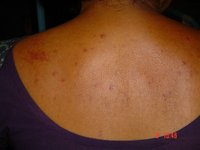Thrombotic thrombocytopenia purpura (TTP) is a serious and often fatal systemic disease manifested as thrombocytopenia, microangiopathic hemolytic anemia, fever, and renal and neurologic symptoms. TTP generally is considered idiopathic but has been associated with use of various medications. The pathophysiology involves the production of an IgG autoantibody against a metalloprotease that degrades von Willebrand factor. The antiplatelet drug ticlopidine has been found to cause TTP in about one of every 1,600 to 5,000 patients treated. Other adverse effects of ticlopidine include neutropenia, adverse skin reactions and gastrointestinal side effects. Because of the problems associated with ticlopidine, a newer agent, clopidogrel, has become more widely used when antiplatelet therapy is indicated for stroke or coronary thrombosis prevention. Both drugs block a binding site on platelets, inhibiting the expression of the glycoprotein IIb/IIIa. Clopidogrel had no reported significant adverse effects, including TTP, when given to almost 20,000 patients in clinical trials. Since its labeling by the U.S. Food and Drug Administration in 1998, clopidogrel has been prescribed to approximately 3 million people. Now that it has achieved widespread clinical use, two cases of TTP have been reported. Bennett and colleagues recently reported the clinical characteristics of 11 patients taking clopidogrel in whom TTP subsequently developed. This adverse event was believed to be serious enough to warrant prepublication release of the information on the Web site of the New England Journal of Medicine.
The 11 patients (six women and five men between 35 and 70 years of age) took clopidogrel between March 1998 and March 2000. The drug was most commonly prescribed to treat coronary artery disease and following coronary stent placement. The duration of therapy ranged from three to 14 days. All patients were actively taking the drug or had recently been taking it at the time TTP was diagnosed. In all patients, the diagnosis was confirmed by clinical and laboratory criteria. Most patients had platelet counts of less than 20,000 per mm3 and hematocrit values of less than 27 percent. Neurologic symptoms such as slurred speech, aphasia, disorientation, confusion and coma developed in seven patients. Four patients had a serum creatinine level of greater than 2.5 mg per dL (221 [micro]mol per L) and two had marked increases in aminotransferase levels, suggesting liver damage.
All patients were treated with plasma exchange, which on average required eight exchanges for resolution of symptoms and laboratory abnormalities. Of these, one patient died. Von Willebrand factor-cleaving protease activity was undetectable in two patients tested, and both of these patients had IgG antibody inhibitors of the protease. Two patients had a relapse within seven months of the initial episode, but both recovered after plasma exchange.
The authors conclude that the early recognition of TTP is of key importance so that treatment with the offending drug is stopped and potentially life-saving plasma exchange can be initiated. Physicians must be aware of the possibility of TTP and its clinical manifestations before prescribing clopidogrel. TTP typically develops within the first two weeks after the initiation of therapy, but recurrence has been reported two months after therapy was discontinued.
EDITOR'S NOTE: Many patients who are given clopidogrel by a cardiologist or neurologist receive follow-up care from their family physician. If TTP is suspected, therapy with the antiplatelet agent must be promptly stopped. Unfortunately, the neurologic symptoms associated with TTP may be mistaken for those of stroke or transient ischemic attack, problems for which the drug was originally prescribed.--j.t.k.
COPYRIGHT 2000 American Academy of Family Physicians
COPYRIGHT 2001 Gale Group



